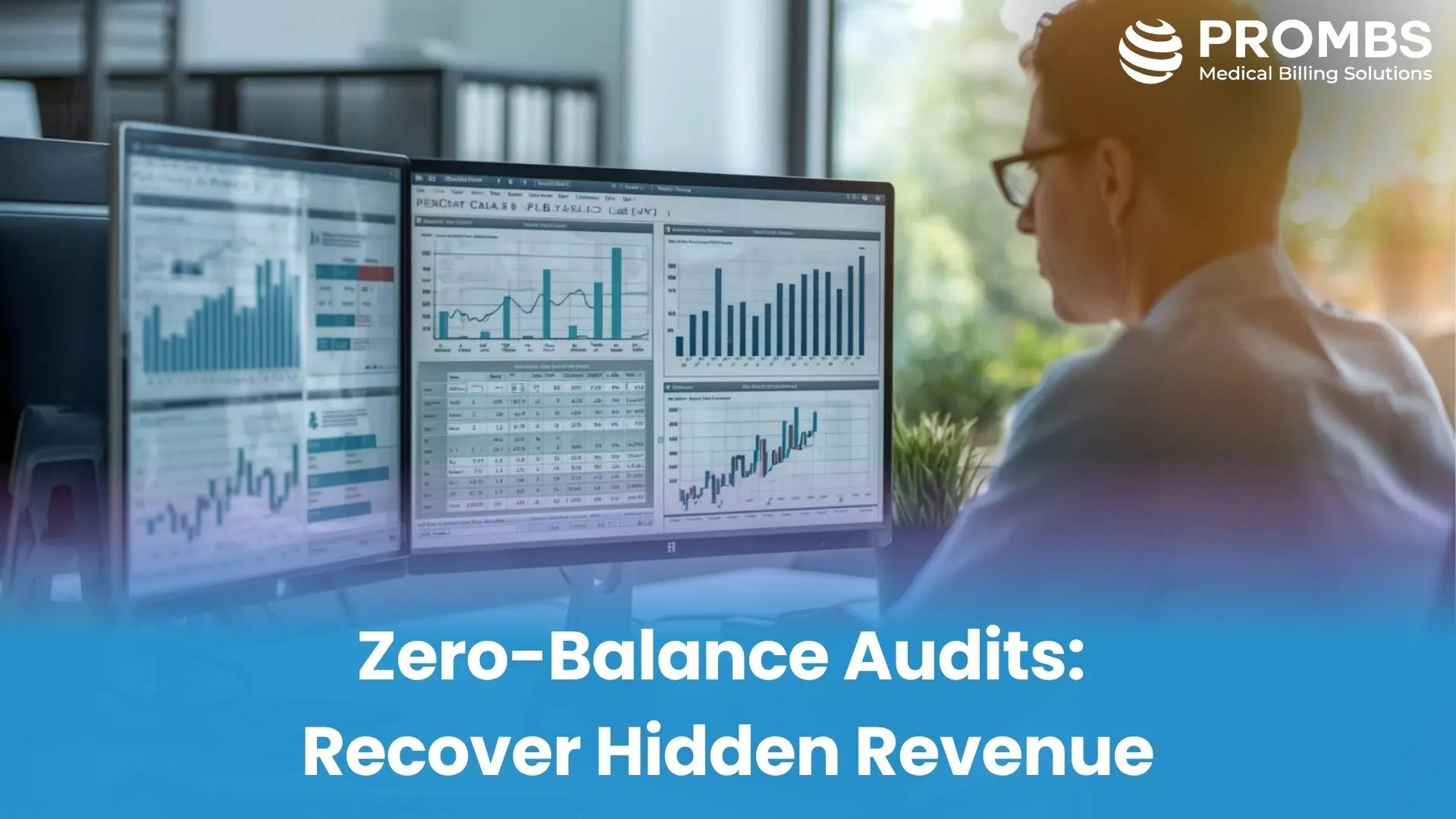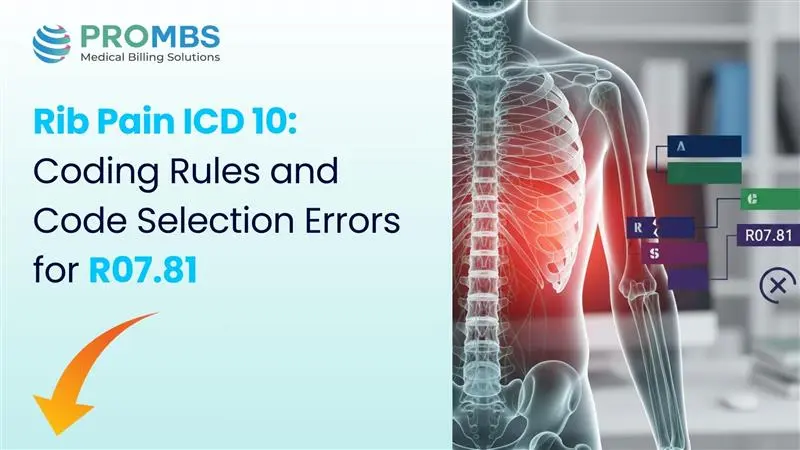A zero-balance AR audit is the review of claims marked “paid in full” to uncover hidden underpayments, contractual misapplications, or missed penalties. The GAO estimated $80B in improper payments across Medicare and Medicaid in 2022, proving why providers cannot take “zero-balance” at face value. PROMBS views zero-balance audits as a dual-purpose tool: they recover lost dollars and ensure compliance with CMS Prompt Pay Rules.
Contract Modeling
The backbone of a successful zero-balance AR audit is accurate contract modeling. Without a strong model that replicates payer terms line by line, it becomes nearly impossible to identify underpayments or missed carve-outs. The American Hospital Association (AHA) highlights that payer contracts have grown increasingly complex, with provisions tied to value-based metrics, carve-outs for specific procedures, and differing timelines for prompt pay compliance.
Why Contract Modeling Is Critical
| Modeling Approach | Key Features | Revenue Integrity Impact |
|---|---|---|
| Outdated / Static Modeling | Uses legacy fee schedules without updates, ignores carve-outs or value-based adjustments, per HFMA audit insights. | Leads to “false zero-balances” where underpayments are never flagged. |
| Advanced Contract Modeling | Dynamically updates payer rules, CPT carve-outs, and risk-based payment formulas as recommended by AHA compliance guidance. | Exposes hidden variances and strengthens audit defensibility. |
| Line-Item Level Reconciliation | Matches reimbursement expectations against CPT/HCPCS and modifier detail, as guided by AMA CPT guidance. | Identifies bundling misapplications and ensures accurate CPT–ICD linkage. |
| Integrated Audit Modeling | Embeds findings into denial prevention workflows, per AHIMA best practices. | Prevents recurring leakage and creates sustainable compliance improvements. |
Advanced modeling ensures providers are not only validating gross payment totals but also verifying every CPT allowance against the contract itself. For example, when contracts allow separate payment for wound repair but the payer incorrectly bundles it into the ED visit, outdated modeling misses the error. PROMBS’ dynamic modeling tools capture these discrepancies, turning them into recoveries and future negotiation leverage.
Did You Know? The Healthcare Financial Management Association (HFMA) found that providers using line-item level contract modeling recover 2–4% more net patient revenue than those relying on outdated fee schedule comparisons. For a $400M health system, that equates to $8M–$16M annually, revenue often left uncollected without a zero-balance audit.
EOB Short-Pay Clues
EOBs often hide systemic revenue leakage. AHIMA notes that small variances in remark codes are frequently ignored by billing teams. When reviewing accounts flagged as zero-balance, the explanation of benefits (EOB) often hides underpayment signals that most billing teams miss. A zero-balance AR audit that digs into EOBs line by line reveals recurring short-pays, contractual misapplications, or bundling edits overlooked during initial posting. According to AHIMA, incomplete review of EOB remark codes is one of the biggest drivers of hidden revenue leakage in post-payment workflows.
| EOB Remark Code | Clue for Underpayment | ICD/CPT Impact |
|---|---|---|
| CO-45 | Indicates contractual adjustment, but discrepancies occur if payer applied the wrong fee schedule, noted by CMS EDI manuals. | May reveal miscalculated allowed amounts for CPT-based services. |
| PR-1 | Deductible not met, but in some cases payer incorrectly applies deductible to services exempt under plan contracts, flagged by HFMA audit resources. | Can impact imaging codes tied to head injuries or emergency services. |
| CO-97 | Denial for bundled services, but contract carve-outs allow separate payment, documented in AMA CPT bundling rules. | Affects procedures like wound repair (12001–12007) when bundled with ED visits. |
| OA-23 | Indicates “impact of prior payer adjudication,” often leading to underpayment on secondary claims per NAIC COB rules. | Seen in coordination-of-benefits errors for dual-coverage patients. |
| CO-109 | Claim not covered by payer, used incorrectly when services are actually covered under policy, as flagged in OIG audit reports. | Denials often reversed on appeal but not fully reimbursed. |
A close reading of EOB remark codes helps revenue cycle teams identify when payers are not following contract language or when coordination-of-benefits (COB) logic is misapplied. For instance, CO-97 bundling errors often hide missed revenue in trauma and ED cases where CPT carve-outs exist. Similarly, OA-23 misapplications result in secondary payers underpaying providers for services already adjudicated by primaries. By capturing these patterns during a zero-balance AR audit, PROMBS helps providers escalate recurring payer issues, recover lost dollars, and use findings as leverage in contract renegotiations.
Did You Know? The Healthcare Financial Management Association (HFMA) has reported that small-dollar variances across high-volume claims can accumulate into millions in annual losses. For a midsize hospital, underpayments of just $25 per claim across 40,000 claims equal $1M in lost revenue each year, revenue often written off unless caught during a zero-balance audit.
By connecting EOB variances into a compliance workflow, we help providers spot recurring payer patterns instead of treating short-pays as random noise.
Interest Penalties
Late payments from payers don’t just slow cash flow, they can also entitle providers to interest penalties under federal and state prompt-pay laws. A zero-balance AR audit often uncovers claims that were technically paid, but paid too late, leaving uncollected interest on the table. The CMS Prompt Pay Guidelines and many state laws mandate that payers reimburse interest when claims exceed statutory deadlines. Yet, most billing teams never pursue these amounts because they are not explicitly listed on standard EOBs.The CMS Prompt Pay Guidelines and many state laws require payers to reimburse providers within a set timeline, or pay interest penalties. Yet these recoveries are often missed because interest is not reflected in standard EOBs. PROMBS cross-references adjudication vs. payment dates, ensuring every eligible claim earns its due penalty. According to the NAIC, prompt pay enforcement is one of the most effective ways providers can regain leverage in payer negotiations.
| Regulation / Rule | Payer Obligation | Provider Impact |
|---|---|---|
| CMS Prompt Pay (Medicare Advantage) | Requires clean claims to be paid within 30 days or accrue interest, per CMS. | Missed interest adds up when Medicare Advantage plans delay large volumes of claims. |
| Medicaid Prompt Pay (varies by state) | States enforce deadlines ranging 15–45 days, interest is mandatory on late payments, noted by Medicaid.gov. | Providers lose revenue if AR teams fail to track state-specific rules. |
| Commercial Payer Prompt Pay Laws | Many states mandate 30-day adjudication for electronic claims, penalties apply if payers exceed the limit, per NAIC. | Missed penalties weaken provider leverage in contract disputes. |
| ERISA Plans | Employer-sponsored plans must pay claims promptly, though interest recovery is often underutilized, per DOL guidance. | Audits reveal late ERISA plan payments where penalties can be pursued. |
| State Insurance Departments | Regulators may enforce fines against payers for systemic late payments, according to OIG enforcement reports. | Documenting late payments strengthens audit findings and payer negotiations. |
Tracking interest penalties is not about nickel-and-dime collections, it’s about enforcing payer accountability. For example, if a commercial payer delays $2M worth of claims for 60 days beyond statutory deadlines, even a modest 12% annual penalty translates into tens of thousands of dollars in lost revenue. PROMBS incorporates this into its zero-balance AR audit workflow, comparing claim adjudication dates with required timelines to ensure providers capture every eligible dollar. This approach not only strengthens financial recovery but also provides data leverage during contract renegotiations with payers.
Did You Know? The National Association of Insurance Commissioners (NAIC) has found that providers who actively pursue prompt-pay interest recoveries improve payer compliance and reduce chronic payment delays by up to 18%. In many cases, payers only begin correcting systemic slow-pay issues once providers demonstrate they are tracking and enforcing penalties.
Worklist Design
Efficient worklist design is the engine that drives a successful zero-balance AR audit. Without structure, AR teams drown in claim-level noise, chasing low-value items while high-impact opportunities remain buried. The Healthcare Financial Management Association (HFMA) stresses that audit ROI is directly tied to how accounts are prioritized and sequenced within worklists. Zero-balance audits succeed when worklists are designed intelligently. Without prioritization, teams drown in thousands of claims with minimal ROI.
Why Worklist Design Matters?
A poorly designed worklist means claims are handled randomly, with no attention to dollar amount, payer type, or denial recurrence. This wastes valuable time and resources. On the other hand, an intelligent worklist filters accounts by high-dollar variances, payer patterns, and systemic issues, ensuring that every auditor hour produces maximum recovery value.
| Worklist Strategy | Description | Compliance & ROI Impact |
|---|---|---|
| Dollar-Value Prioritization | Claims with the highest underpayment potential are pushed to the top of the queue, per HFMA guidelines. | Maximizes revenue recovery within limited audit resources. |
| Payer Risk Profiling | High-risk payers with histories of bundling errors or chronic underpayment are flagged, following OIG payer monitoring reports. | Builds leverage in payer contract renegotiations. |
| Denial Pattern Recognition | Claims linked to recurring denial codes (CO-97, CO-109, etc.) are clustered for batch review, supported by AHIMA best practices. | Reduces repetitive rework and accelerates appeal cycles. |
| Encounter-Type Tracking | Claims are sorted by encounter type (initial, subsequent, sequela), as defined in CMS ICD-10 documentation rules. | Ensures compliance coding integrity, avoiding denials tied to incomplete encounters. |
| System Integration | Worklists connect with EHR and RCM platforms, creating dashboards that CFOs and compliance teams can monitor in real time. | Enhances audit transparency and executive oversight. |
How PROMBS Optimizes Worklists
At PROMBS, we build tiered worklists that are dynamic rather than static. For example, instead of just flagging claims above $5,000, we design rules that escalate high-volume $100 short-pays if they recur across thousands of claims. This balance of granularity and scale ensures no leakage goes unnoticed. Our dashboards provide a compliance-first view, so providers can see not just dollars recovered, but also payer behavior trends. This means zero-balance AR audits become both a revenue recovery tool and a strategic intelligence tool for CFOs and compliance officers. By linking worklist design to denial prevention, PROMBS ensures providers capture value today while also reducing underpayments tomorrow.
The HFMA confirms that targeted post-payment reviews deliver higher ROI than generic approaches. PROMBS enhances this by embedding audit dashboards that CFOs can monitor in real time.
Did You Know? According to the Healthcare Financial Management Association (HFMA), providers that adopt structured AR worklists improve recovery efficiency by 25–40%, since auditors spend less time chasing random claims and more time resolving high-impact variances. In one HFMA case study, hospitals that restructured their AR worklists saw audit ROI double within 12 months.
Case Studies & ROI
The most convincing proof of a zero-balance AR audit is not theory, but real-world outcomes. Providers who conduct post-payment reviews consistently uncover millions in lost revenue and improve payer accountability. The Becker’s Hospital Review reports that post-payment audits can deliver 200–400% ROI, making them one of the most effective revenue integrity strategies.
| Provider Type | Audit Findings | ROI & Compliance Impact |
|---|---|---|
| Midwest Hospital System | Identified $3.2M in underpayments from commercial payers over 6 months, linked to incorrect contract applications. | Delivered a 350% ROI, as reported in Becker’s case study. |
| Specialty Physician Group | Detected recurring bundling errors under CO-97 codes, appealed and recovered unpaid CPT carve-outs. | Strengthened leverage in payer contract renegotiation, per HFMA payer audit reports. |
| Behavioral Health Provider | Uncovered $600K in missed interest penalties under state prompt-pay laws. | Improved compliance and enforcement of NAIC prompt-pay statutes. |
| Large ASC Network | Detected short-pays averaging $50 per case across 20,000 procedures annually. | Recovered $1M, showing how “small variances” scale, highlighted by AHIMA audit best practices. |
Case studies like these demonstrate that zero-balance audits are not just a recovery exercise, they provide strategic insight into payer behavior. For hospitals, the findings may lead to systemic contract renegotiations, for physician groups, they highlight bundling misapplication,; and for ASCs, they expose the hidden impact of small-dollar variances across high volume. The ROI isn’t only financial, it also strengthens compliance posture by proving providers can enforce payer obligations in line with OIG oversight expectations. As Becker’s Hospital Review notes, zero-balance audits can deliver 200–400% ROI, making them one of the most cost-effective revenue integrity tools.
Did You Know? According to the HFMA, providers that perform annual zero-balance audits increase net revenue capture by 1–3% of total patient revenue. For a $500M health system, this equals $5–15M in annual recoveries, revenue that otherwise would have been written off as “paid in full.”
Why Zero-Balance Audits Safeguard Providers
A zero-balance AR audit is more than a recovery exercise, it is a compliance safeguard and a strategic tool for enforcing payer accountability. In an era where GAO reports over $80B in improper payments annually, providers cannot afford to trust that “paid in full” truly means “paid correctly.” These audits uncover underpayments, missed interest penalties, and systemic payer errors while also giving CFOs leverage in contract negotiations. By aligning with CMS prompt-pay rules, OIG oversight, and HFMA best practices, PROMBS ensures providers not only recover hidden dollars but also build a stronger compliance posture for the future.
Compliance Insight
Providers who treat zero-balance audits as ongoing compliance tools, rather than one-time recovery projects, consistently achieve higher ROI, stronger payer negotiations, and reduced audit risk. At PROMBS, we transform “zero-balance” into “zero leakage” by combining advanced contract modeling, denial workflow design, and payer-specific intelligence.
Why PROMBS Is the Right Partner for Zero-Balance Audits
Choosing the right partner for a zero-balance AR audit can be the difference between recovering a few missed claims and uncovering millions in hidden revenue. Many firms run surface-level reviews, but PROMBS takes a compliance-first approach, ensuring that every recovery aligns with payer contracts, regulatory requirements, and industry best practices. Our methodology combines deep contract modeling, line-item EOB analysis, and denial workflow design to expose variances that generic AR teams miss.
Unlike firms that focus solely on financial recovery, PROMBS emphasizes audit defensibility. By aligning audits with CMS billing rules, OIG work plan priorities, and HFMA revenue integrity frameworks, we not only secure dollars but also safeguard providers from compliance risk. This means our clients are prepared not only to recover revenue but also to stand strong in the face of payer disputes or regulatory audits.
PROMBS also integrates its auditing insights into ongoing revenue cycle operations. For example, the same intelligence that helps uncover missed EOB short-pays is embedded into our denial prevention workflows and guides like the CMS-1500 Claim Form Guide, POS 10 Telehealth Guide, and Mastering Modifiers Guide. This ensures zero-balance audits are not just a retrospective fix but part of a forward-looking strategy that strengthens revenue integrity year after year.



